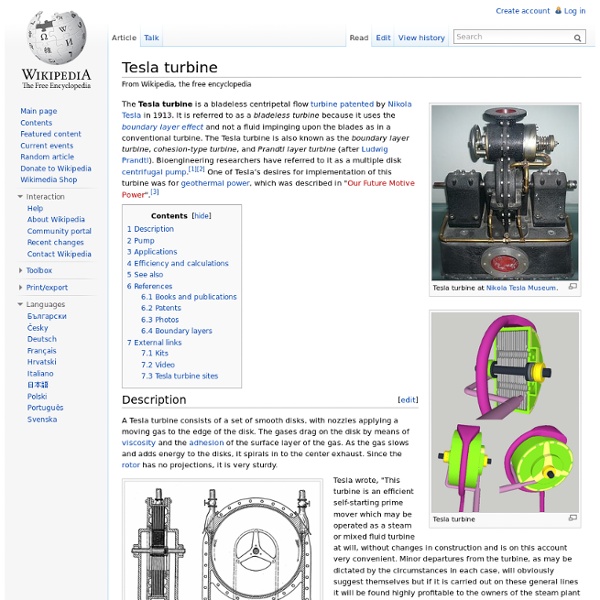Build a 15,000 rpm Tesla Turbine using hard drive platters
Here's a project that uses some of those dead hard drives you've got lying around. In the Tesla Turbine, air, steam, oil, or any other fluid is injected at the edge of a series of smooth parallel disks. The fluid spirals inwards and is exhausted through ventilation ports near the center of the disks. A regular blade turbine operates by transferring kinetic energy from the moving fluid to the turbine fan blades. In the Tesla Turbine, the kinetic energy transfer to the edges of the thin platters is very small. Instead, it uses the boundary layer effect, i.e. adhesion between the moving fluid and the rigid disk. To build a turbine like this, you need some dead hard drives, some stock material (aluminum, acrylic), a milling machine with a rotary table, and a lathe with a 4 jaw chuck. Wikipedia has a good review article ( as well as articles about I run my turbine on compressed air (40 psi), and it easily reaches speeds of 10-15,000 rpm.
Tesla turbines for highschool students
Here are some photos of some Tesla Turbines my Highschool Engineering students created as part of their studies into mechanisms and power transfer. Their brief was to investigate experimental power generation systems and create a prototype using available materials. I have provided the Task Overview below. Once the turbines where complete we tested their RPM and efficiency using a car timing light, changed and improved parts such as bearings etc and retested to see improvements in efficiency. Task Overview (scenario) Global - Tech Engineering are a socially conscious Engineering firm. The system must have the following considerations: high efficiency. made from available, cost efficient materials (preferably recycled or low impact materials). environmentally sound (no harmful by-products or toxic materials). small – scale or easily disassembled. be able to be mass produced in a standard workshop.
Student invention lets Guatemalans pump water on the go
University of Sheffield student Jon Leary was required to “make something useful out of rubbish” as part of his dissertation. What he ended up doing was transforming lives. As part of his studies as a Mechanical Engineering major, Leary spent four months in Guatemala. There, he introduced the locals to his bicibomba movil, a mobile bicycle-powered water pump. View all Leary developed the system while still in the UK. “The inspiration came from regular pannier racks that are used on touring bikes to carry things over the back wheel of a bike” Leary told us. The bicibomba movil was introduced with the help of Maya Pedal, a local organization that champions pedal-powered technology in the region. The mobile aspect of Leary’s invention, however, makes it attractive to farmers. Jon’s device can reportedly be made quite easily, using standard tools along with old bikes, bits of metal, and scrapped electric centrifugal water pumps.
Build an Amazing Tesla CD Turbine
Build a real working turbine from recycled CD's! This Tesla CD Turbine is based on the Tesla turbine, which was invented by Nikola Tesla in the early 1900's. Tesla's pumps and motors were unique in that they only used discs, and took advantage of the boundary layer effect. His smallest designs were over 100 horsepower. This Instructable is an introduction to my recently developed Tesla CD Turbine, which is made from CD's, CD spindle, pipe fittings and glue. The basic model Tesla CD Turbine shows how the boundary layer idea works to deliver power. The advanced model has many cool features, such as the use of neodymium magnets to separate the CD's with the correct gap and a Magnetic Coupler to attach implements, and much more. My next CD Turbine Instructable shows how to make a Magnetic Disc Pack and Magnetic Coupler for more advanced CD Turbine experimentation. However, please be forewarned that this turbine on air pressure is not really a kid's toy or particularly safe to operate.



